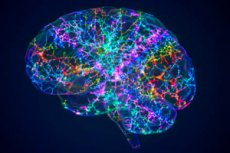Nye publikasjoner
"MUSIC-kart" viser at noen hjerneceller eldes raskere
Sist anmeldt: 02.07.2025

Alt iLive-innhold blir gjennomgått med medisin eller faktisk kontrollert for å sikre så mye faktuell nøyaktighet som mulig.
Vi har strenge retningslinjer for innkjøp og kun kobling til anerkjente medieområder, akademiske forskningsinstitusjoner og, når det er mulig, medisinsk peer-evaluerte studier. Merk at tallene i parenteser ([1], [2], etc.) er klikkbare koblinger til disse studiene.
Hvis du føler at noe av innholdet vårt er unøyaktig, utdatert eller ellers tvilsomt, velg det og trykk Ctrl + Enter.

Ingeniører ved University of California, San Diego, har oppdaget at noen hjerneceller eldes raskere enn andre, og de er uforholdsmessig tallrike hos personer med Alzheimers sykdom. Forskerne observerte også forskjeller i aldringsprosessen til visse hjerneceller avhengig av kjønn: Hjernebarken hos kvinner har en høyere andel av «gamle» oligodendrocytter sammenlignet med «gamle» nevroner sammenlignet med hjernebarken hos menn.
Disse oppdagelsene ble muliggjort av en ny teknikk kalt MUSIC (kartlegging av nukleinsyreinteraksjoner i enkeltceller), som lar forskere kikke inn i individuelle hjerneceller og kartlegge interaksjonene mellom kromatin – den tett sammenrullede formen av DNA – og RNA. Teknikken gjør det mulig å visualisere disse interaksjonene på nivå med individuelle celler og studere hvordan de påvirker genuttrykk.
«MUSIKK er et kraftig verktøy som lar oss få dypere innsikt i de komplekse aspektene ved Alzheimers sykdom », sa seniorforfatter av studien, Sheng Zhong, professor ved Shu Chien-Gen Lai-instituttet for bioingeniørfag ved Jacobs School of Engineering ved University of California, San Diego.
«Denne teknologien har potensial til å avdekke nye molekylære mekanismer som ligger til grunn for Alzheimers sykdomspatologi, noe som kan bane vei for mer målrettede terapeutiske tiltak og forbedrede resultater for pasienter.»
Den menneskelige hjernen inneholder et komplekst nettverk av celler som kommuniserer og samhandler på komplekse måter. Innenfor hver av disse cellene samhandler genetiske komponenter, inkludert kromatin og RNA, dynamisk for å bestemme kritiske cellulære funksjoner. Etter hvert som hjerneceller vokser og eldes, endres disse interaksjonene mellom kromatin og RNA. Og disse kompleksene kan variere sterkt fra celle til celle, spesielt i modne celler. Å avdekke komplikasjonene ved disse interaksjonene har imidlertid forblitt en utfordring.
Til unnsetning kom en teknikk kalt MUSIC, som gir et vindu inn i de indre funksjonene til individuelle hjerneceller. Ved hjelp av MUSIC analyserte Zhongs team hjerneprøver etter døden, nærmere bestemt vev fra menneskelig frontal cortex, fra 14 donorer i alderen 59 år og eldre, noen med Alzheimers sykdom og noen uten.
De fant ut at ulike typer hjerneceller viste ulike mønstre av interaksjoner mellom kromatin og RNA. Interessant nok viste celler med færre korte kromatininteraksjoner oftere tegn på aldring og Alzheimers sykdom.
«Ved å bruke denne transformative teknologien til å analysere individuelle celler, fant vi ut at noen hjerneceller er eldre enn andre», sa Zhong. Han forklarte at personer med Alzheimers hadde et høyere antall av disse eldre hjernecellene enn friske mennesker.
Forskere mener oppdagelsen kan bidra til å utvikle nye behandlinger for Alzheimers sykdom.
«Hvis vi kan identifisere dysregulerte gener i disse gamle cellene og forstå deres funksjoner i den lokale kromatinstrukturen, kan vi kanskje også identifisere nye potensielle terapeutiske mål», sa førsteforfatter av studien, Xingzhao Wen, en doktorgradskandidat i bioinformatikk i Zhongs laboratorium.
Studien fant også kjønnsforskjeller i hvordan hjerneceller eldes. I hjernebarken hos kvinner fant forskerne et høyere forhold mellom gamle oligodendrocytter og gamle nevroner. Oligodendrocytter er en type hjernecelle som danner et beskyttende lag rundt nevroner. Gitt deres kritiske rolle i å opprettholde normal hjernefunksjon, kan økt antall gamle oligodendrocytter forverre kognitiv nedgang.
«Den uforholdsmessig store tilstedeværelsen av senescente oligodendrocytter i hjernebarken hos kvinner kan kaste nytt lys over den økte risikoen for nevrodegenerative og psykiatriske lidelser observert hos kvinner», sa Wen.
Det neste steget for forskerne vil være å optimalisere MUSIC ytterligere, slik at den kan brukes til å identifisere faktorer – som regulatoriske gener og genetiske kretser – som er ansvarlige for akselerert aldring i visse hjerneceller.
"Vi vil deretter utvikle strategier for å undertrykke aktiviteten til disse genene eller kretsene, i håp om å bremse hjernens aldring," sa Zhong.
Resultatene av arbeidet er beskrevet i detalj i en artikkel publisert i tidsskriftet Nature.
